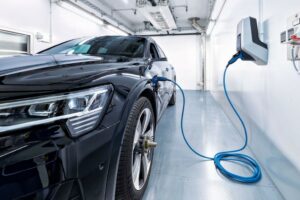To make the change to CO2-free transport possible, the hydrogen fuel cell is another alternative to power electric vehicles. Read our sixth scenario to see how a rapid scale-up of hydrogen production leads to a high share of FCEVs while other types of powertrains fall behind.
Awareness for climate neutral activity developed in all sectors including transport, hydrogen is the main solution to store and transport the fluctuating renewable energies in relevant amounts that ensure free access to energy for all and therefore the wealth of countries without compromising climate protection.
After several governments launched major initiatives to encourage the need for hydrogen in energy-intensive industries such as iron production, but also as basis for fueling road freight and especially air transport, the large-scale industrial production of hydrogen became increasingly important. As well as carbon capture and storage technologies (CCS), pyrolysis for producing hydrogen from natural gas is not yet suitable for cost-competitive large-scale production. That is the reason why carbon neutral hydrogen is mainly produced from renewable electricity with water electrolysis. Producing countries are mostly located in sun-rich regions such as the North African states and the Middle East, where seawater is desalinated with large-scale solar thermal and photovoltaic systems before being broken down in electrolysers. In order to enable the necessary high utilization rates of the facilities, those solar power plants can be equipped with energy storage systems that enable overnight operation. Afterwards, tankers ship the collected hydrogen to European ports. The increasing demand from more and more sectors, such as the air traffic mentioned above, but also home heating systems for which few climate-neutral alternatives are available, has enabled economies of scale in these production plants, which has further reduced prices.
Many customers prefer FCEV over BEV as a result of the higher achievable ranges and the fast and familiar refueling procedure.
Due to the falling prices of the energy carrier, technological innovations and the scaling over all sectors, fuel cell powertrains achieved price parity with battery electric vehicles in 2025. Many customers prefer FCEV over BEV as a result of the higher achievable ranges and the fast and familiar refueling procedure. In the segment for commercial vehicles FCEV are now the only economic reasonable solution for CO2 neutral solutions. It became evident that the fuel cell gained the predominance over hydrogen combustion in ICEs due to the efficiency disadvantages during dynamic driving conditions in passenger cars. The requirements of many European city centers for passenger cars free of toxic emissions and low noise led to a rejection of internal combustion engines regardless of the fuel type. Even if e-fuels have been a lever to reduce the CO2 emission of the existing fleet, such penalties as well as higher taxes have pushed them out of the market for new vehicles.
With the increasing attention of customers, a large-scale expansion of the refueling infrastructure, which is supplied via pipelines or tank trucks, began, supported by the European Union. There was a Europe-wide consolidation of gas station operators, as small suppliers could not afford to convert to hydrogen filling stations. The winners of this development are large gas station chains, which started with conversions at an early stage and were able to secure further market shares in the supply network for themselves and their franchise-partners. In addition, new suppliers such as wind farm operators emerged, who sold surplus electricity as hydrogen using their own electrolysers and filling stations. Costumers benefited from the rapid spread of hydrogen filling stations, which made inter-European travel possible.
Costumers benefited from the rapid spread of hydrogen filling stations, which made inter-European travel possible.
The associated shift towards system components required for fuel cell drives was a disaster for hesitant traditional ICE suppliers. However, those market players who had recognized change early on and adapted their product roadmap to the megatrend of CO2-free transport were able to gain significant shares in a rapidly growing market.
In your opinion, how will the powertrains in the mobility industry evolve? This European scenario derives a change for the future powertrain portfolio towards the hydrogen fuel cell to power passenger cars as well as commercial vehicles. What could be the impact on the mobility behavior if hydrogen is considered as the future energy carrier for the electric powertrain?
So what will be the powertrain of your future mobility?
A mobility Scenario by
R.Troeger@consulting4drive.com

